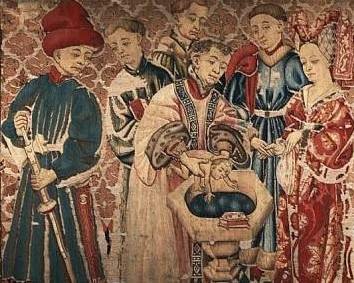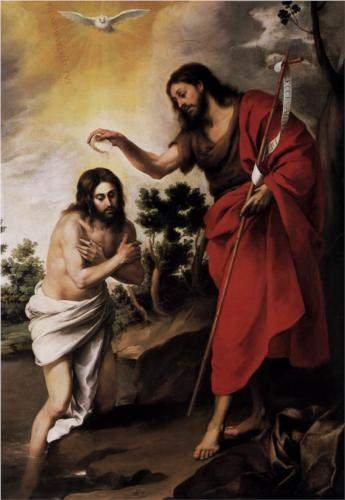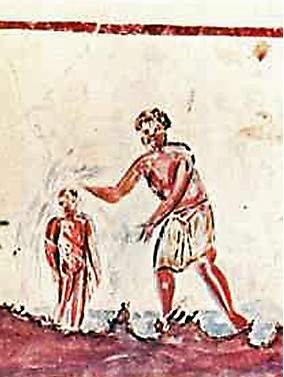(Here is a note that originated as a comment to a friend on Facebook, voicing my concerns about something I’ve never spoken about here before: “Hebrew Roots” Christianity or “Messianic Judaism.”)
I have mixed feelings about the Messianic and “Hebrew Roots” movements. (I don’t know if it’s fair to lump those together or not. I think the two have different origins, but work from similar principles.) I think it’s definitely valuable to understand the Hebrew context and roots of the Christian faith, to seek to recover valuable traditions — but at the same time, many of the people I’ve talked to tend to be anti-traditional and iconoclastic in the opposite direction, toward all established Christian tradition, both Protestant and especially Catholic.
Christianity has come down to us by way of a 2,000-year-old tradition — 2,000 years of faithful men and women who have believed and followed God and preserved and handed down the faith. And if one isn’t careful about it, this “Hebrew Roots” movement implies a renunciation of all that. It seems to be the extreme end of the attitude that was born in the Reformation: let’s go back and recover the original Christian faith; let’s find a “pure” faith, and throw away anything else that’s been added.
But I think it’s dangerous to separate faith from history and tradition. I think it was dangerous (and harmful) for the Protestant Reformers to separate the faith from so much of the tradition through which they had received it — so many babies thrown out with the dirty bathwater — and Protestants have been lacking some necessary elements ever since. The Protestant notion of sola scriptura put forward the idea that all one needs to have Christian faith is “Scripture alone,” so it’s only logical to suppose that if we strip away all the tradition, even the Protestant tradition, we’ll end up with what we were originally supposed to have. But that presumes that the Protestant idea was correct in the first place. I get the feeling that much of what is driving this movement is frustration with the disorder and fragmentation the Protestant tradition is in — it was the same frustration that has led me and many others to rediscover the Catholic Church — but that disorder ought to be an indication that something has gone wrong in the principles and premises of Protestantism, not in the whole of Christian tradition. It seems to be a foregone concluson among Protestants that the Catholic Church is a corrupt and unviable option; perhaps they should take a closer look at that before they dismiss it.
Yes, Jesus and the Apostles were Jews, and the Christian faith is the fulfillment of Hebrew prophecy and the culmination of Hebrew tradition. Yes, the earliest Christians were all Jewish and sought to preserve their Jewish identity in addition to being followers of the Messiah. But Protestants, especially those in this “Hebrew Roots” movement, presume that the historic, Catholic Church unfaithfully put aside those Jewish traditions or overwrote them with syncretistic or pagan or otherwise compromised doctrines. And separating the faith from history, presuming that Scripture is the only source one needs, makes it easy to believe that.
But the fact is that history presents a very different story. By the beginning of the second century, mere years after the deaths of the Apostles, the Christian and Jewish traditions were already parting ways. The Jews rejected Christians as anti-Jewish heretics, and Christians came to reject Jewish traditions as subversive and anti-Christian. Christian worship on the Lord’s Day (Sunday) had been a practice since the Apostles themselves (which Scripture itself supports), and the growing Church, as Christians were expelled from the synagogues, soon fell away from also celebrating Jewish worship on the Sabbath.
To sever faith from history forgets all of that and denies it happened. To cast away the Tradition of the Church loses the whole context of the New Testament and the Early Church, and with it the authentic teaching of the Apostles on how Christian worship was to be conducted. The liturgy of the Catholic Mass even to this day clearly follows the forms of the Jewish synagogue liturgy. The “Hebrew Roots” of Christianity are not lost; they merely grew into full-grown oaks.
On the other hand, “Hebrew Roots” and Messianic Judaism in fact adopt a fabricated tradition — an invention of someone or another’s subjective conception of how early Jewish Christians would have worshipped — since no authentic tradition of Judaic Christianity descends to us. It takes on a false form of ancience and tradition, and in fact “adds to the faith” as much as Protestants have ever accused Catholics of doing, only adding genuine novelty and invention rather than what they only presume to be. It tends to be based on a very Protestant reading of Scripture (it doesn’t cast away that tradition wholly), and suffers from the same basic fallacies: by ignoring the received tradition of the Church, it misses many of the crucial understandings and connections which early Christian writers and the Church Fathers realized and retained and have handed down to us. Even more troubling, I’ve encountered advocates of Christians returning to the observance of the Torah, the Jewish Law, when Scripture is quite clear that this is opposed to or even negates faith in Christ.
Scripture is clear that followers of Jesus, particularly Gentile believers, were under no obligation to observe the Torah or maintain Jewish practices, and if anything, even for Jews, these distracted from the fulfillment and revelation of Christ. The Epistle to the Hebrews tells us that God, “in speaking of a new covenant, treats the first as obsolete. And what is becoming obsolete and growing old is ready to vanish away” (Hebrews 8:13). Paul told the Colossians to “let no one pass judgment on you in questions of food and drink or with regard to a festival or a new moon or a sabbath [the principal elements of Jewish observance]. These are only a shadow of what is to come; but the substance belongs to Christ” (Colossians 2:16–17). In fact, the whole message of Paul against the heresy of the Judaizers was for Christians not to allow themselves to again be placed under the yoke of the Jewish Law, to seek justification with God through religious observance and not through faith in Christ. “You are severed from Christ, you who would be justified by the law; you have fallen away from grace” (Galatians 5:4).







